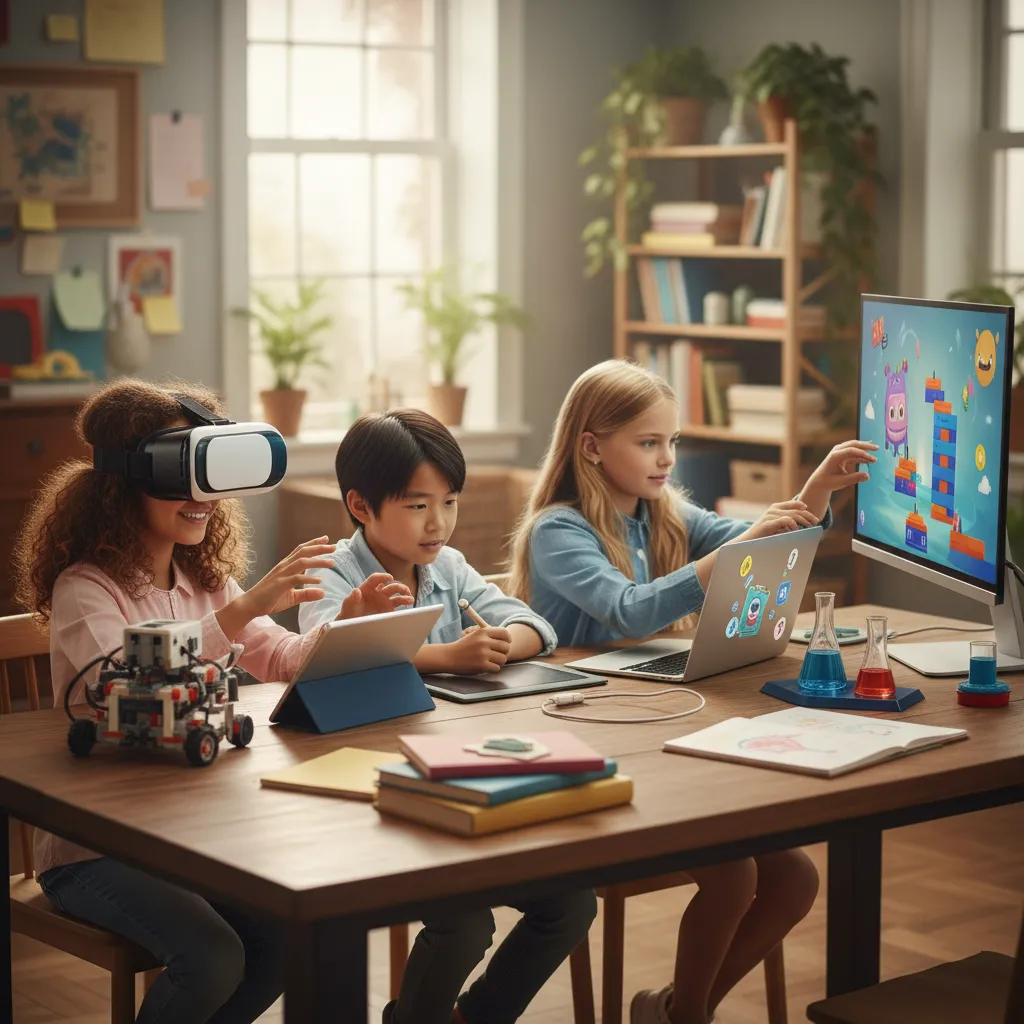Best Online Learning Programs for Kids: Fun and Educational Classes
In today’s digital age, parents and educators are constantly searching for the best online learning programs for kids that combine genuine learning outcomes with engagement and fun. The right program supports academic growth, builds confidence, and sparks curiosity - all while fitting into busy family schedules. This guide, written from the perspective of an experienced marketer with a decade of experience helping parents and schools choose the right EdTech, walks you through practical criteria, top platforms, subject-specific options, and real-life tips to keep kids motivated. Each section includes actionable advice and examples to help you pick the best fit for your child.

Understanding Online Learning for Kids
Online learning for children is not merely moving classroom lectures online - it’s a redesign of learning experiences using multimedia, interactivity, and adaptive instruction. The modern platforms mix video, games, live instruction, and project-based work so children can learn actively instead of passively. A strong program recognizes different learning styles and includes checks for comprehension, progress reports, and meaningful feedback.
The shift from passive to interactive learning
Historically, many digital resources were static: worksheets, scanned textbooks, or recorded lectures. Today’s best programs use interaction as the backbone - short tasks, immediate feedback, and game-like progressions keep attention and accelerate retention. For parents, this means the curriculum is often more engaging and measurable.
Why engagement matters
Kids learn best when they’re curious and emotionally invested. Engagement reduces resistance to hard topics (like fractions or grammar rules) and helps children practice consistently. Look for platforms that reward persistence, celebrate milestones, and use stories or characters to make lessons memorable - example: a reading program that unlocks chapter illustrations after a quiz.
Why Parents Choose Online Learning Programs
Parents choose online classes for many reasons: flexibility, enrichment, remediation, or access to niche subjects. The convenience of scheduling, the ability to tailor content to skill gaps, and the chance for children to explore interests outside the school day are major draws.
Flexibility and scheduling
A program that allows lessons at any time helps families balance school, extracurriculars, and family commitments. This flexibility often leads to more consistent learning habits because children can practice when they’re most receptive.
Personalization and remediation
Adaptive platforms can assess the child’s level and offer targeted practice. For kids who need remediation, this means focusing on weak skills without boredom from repeating mastered topics. For advanced learners, it offers extension work that keeps them challenged - example: an adaptive math engine that re-teaches a concept with simpler steps then adds enrichment tasks.
Top Features to Look for in Online Programs
Not every colorful app delivers learning. Prioritize features that indicate education-first design: adaptive pathways, progress tracking, qualified instructors (for live classes), safety and privacy controls, and assessment tools.
Interactivity and active learning
Look for short interactive tasks rather than long passive videos. Programs that scaffold learning into micro-lessons with checks for understanding create stronger learning loops.
Reporting and parent dashboards
Good parent dashboards show measurable progress and recommend next steps. These should be readable at a glance and include actionable insights like “repeat phonics module 3 before moving on.”
Safety and privacy
Children’s platforms must follow strict privacy practices and avoid ads or in-app purchases that encourage impulsive spending. Verify data policies and whether the platform complies with local regulations for children’s online privacy.
Best Online Learning Programs for Kids (Platform Highlights)
Below are categories and standout programs widely used by families and schools. Each choice is paired with practical examples of how families use them.
ABCmouse (early learners)
ABCmouse focuses on pre-K through early elementary years with a structured learning path that mixes stories, songs, and games. Families use it for daily literacy and numeracy practice in 10–20 minute sessions - example: morning phonics warm-ups before breakfast.
Khan Academy Kids (free, foundational)
Khan Academy Kids is a robust, no-cost platform for preschool and early elementary learners with adaptive content and a strong literacy focus. It’s ideal for supplementing school work and for summer retention.
Outschool (live, interest-based classes)
Outschool connects kids to live small-group classes on almost any topic - from creative writing to robotics. It’s excellent for kids who thrive in live social learning and for discovering niche passions.
Prodigy (game-based math practice)
Prodigy turns math skills into a role-playing game where solving problems advances the story. It’s especially useful for reluctant learners who need motivational scaffolding.
Tynker & Code.org (coding & STEM)
Both platforms teach coding through gamified lessons and project-based work. Tynker has guided paths for different ages; Code.org offers free lessons and Hour of Code activities used by many teachers.
Duolingo for Kids (language learning)
Duolingo makes language learning bite-sized and reward-driven - great for early exposure to a second language through short daily practice.
BrainPOP & Mystery Science (science and inquiry)
BrainPOP offers animated explainers and assessment; Mystery Science gives hands-on investigations ideal for family experiments and classroom use.
Reading Eggs & Epic! (literacy and books)
Reading Eggs focuses on phonics and early reading sequence; Epic! is a massive digital library suitable for independent reading time and book-based activities.
Adventure Academy (upper elementary virtual world)
Adventure Academy creates an educational MMO for older kids where learning is embedded in exploration and missions - helpful for mixed-subject review.
Yousician & Skoove (music learning)
These apps offer interactive instrument lessons with immediate feedback and progression tracking - great for motivated kids practicing instruments independently.
Online Programs by Subject Area
Choosing a program often depends on the target subject. Below are pragmatic recommendations organized by main subjects.
Math
- Prodigy: motivates practice through narrative.
- DreamBox: adaptive sequence for deeper conceptual understanding.
- Khan Academy: free videos and practice aligned with grade standards.
- Example: use DreamBox for targeted remediation, then Prodigy for practice and engagement.
Reading & Literacy
- Reading Eggs: systematic phonics sequences.
- Epic!: broad book library, great for fostering independent reading habits.
- Example: combine Reading Eggs’ structured lessons with Epic!’s free-choice reading to strengthen both skill and motivation.
Science
- BrainPOP: concise concept videos with follow-up quizzes.
- Mystery Science: hands-on lessons you can do at home.
- Example: watch a BrainPOP video, then do a Mystery Science experiment to apply the concept.
STEM & Coding
- Tynker and Code.org for coding fundamentals.
- LEGO Education blends tactile building with coding challenges.
- Example: pair a Code.org unit on loops with a LEGO robotics challenge to deepen understanding.
Arts and Creativity
- Outschool live art classes, Storybird for creative writing, and Tinker Crate for DIY STEAM kits.
- Example: a monthly Outschool art workshop plus a daily 15-minute sketch habit builds skills and confidence.
Creative and Artistic Programs
Creativity fuels learning across subjects. Programs that emphasize art, music, or storytelling strengthen emotional expression, communication, and synthesis skills.
Art and design
Outschool and project-based kits encourage cumulative skill-building. Look for classes that culminate in a portfolio piece - tangible outcomes sustain motivation.
Music and performing arts
Apps like Yousician support independent practice, while live lessons or group choirs build social skills and performance confidence.
Storytelling and writing
Platforms that let children publish (like Storybird) offer authentic audiences, which is one of the strongest motivators for young writers.
STEM and Coding Programs for Kids
STEM pathways should emphasize hands-on projects, debugging mindset, and iterative improvement. Coding platforms that incorporate storytelling keep concepts meaningful.
Why start early?
Early exposure builds computational thinking - breaking problems into steps, recognizing patterns, and testing hypotheses. These cognitive habits transfer to math, science, and everyday problem-solving.
Recommended progression
Begin with block-based coding (Tynker, Scratch) then move to text-based languages (Python basics) when the child is ready. Complement screen work with offline challenges: robotics, maker kits, and simple electronics.
Social and Emotional Learning (SEL) Online
High-quality programs integrate SEL into the curriculum so children learn self-regulation, empathy, and collaboration alongside academics.
SEL platforms and tools
ClassDojo and Positive Action provide activities that teach emotional vocabulary and conflict resolution skills. SEL reduces anxiety around school and improves classroom behavior and learning outcomes - example: a morning check-in routine that uses a feelings chart to set the day’s emotional goal.
How parents support SEL online
Model emotional labeling, discuss mistakes as learning opportunities, and praise effort. Online platforms give prompts, but real-world reflection makes the learning stick.
How to Motivate Kids in Online Learning
Motivation is the engine of learning. Use structure, variety, and recognition to keep momentum.
Create a learning routine
Consistent times for online lessons help normalize practice. Short, frequent sessions beat marathon study blocks.
Use mixed-format learning
Alternate independent practice, live classes, projects, and hands-on activities. Variety prevents burnout and supports multiple intelligences.
Reward progress, not perfection
Celebrate completed modules, consistent streaks, or creative project outcomes. Tangible and social rewards - a family showcase night for projects - help maintain enthusiasm.
Tips for Choosing the Right Program
Picking the right program requires matching the tool to the child’s needs, not simply following popularity.
- Define the goal: remediate, supplement, accelerate, or explore?
- Trial before purchase: use free trials to test fit with your child’s attention span and learning style.
- Read reviews and sample content: check both expert reviews and parent experiences.
- Ensure alignment with school or standards if academic catch-up matters.
- Check logistics: device requirements, class schedules, and cancellation policies.
- Prioritize safety: no ads, child data protections, and clear moderation for live classes.
- Example: if the goal is to boost reading fluency, try a 4-week trial of Reading Eggs and measure words-per-minute before and after.
The Future of Online Learning for Kids
The future holds more personalization and immersion. Expect AI-driven tutoring, VR/AR experiential lessons, and more hybrid models that blend in-person and online strengths.
AI and personalization
AI will increasingly tailor difficulty, pacing, and content types to the learner’s profile. This means fewer wasted hours and more targeted growth.
Immersive experiences
VR and AR promise field trips to ancient cities or inside a cell - experiences that are difficult to replicate in the physical classroom but highly memorable and motivating.
Conclusion
Selecting the best online learning programs for kids is about aligning the child’s needs with program strengths: engagement, adaptivity, and rigor. Whether you prioritize literacy, math, STEM, creativity, or SEL, the right blend of tools will keep your child learning consistently and joyfully. Start with clear goals, use trials to test fit, and maintain a routine that balances screen learning with hands-on projects. With thoughtful choices and parental support, online learning programs can be powerful allies in building skills, confidence, and a lifelong love of learning.











